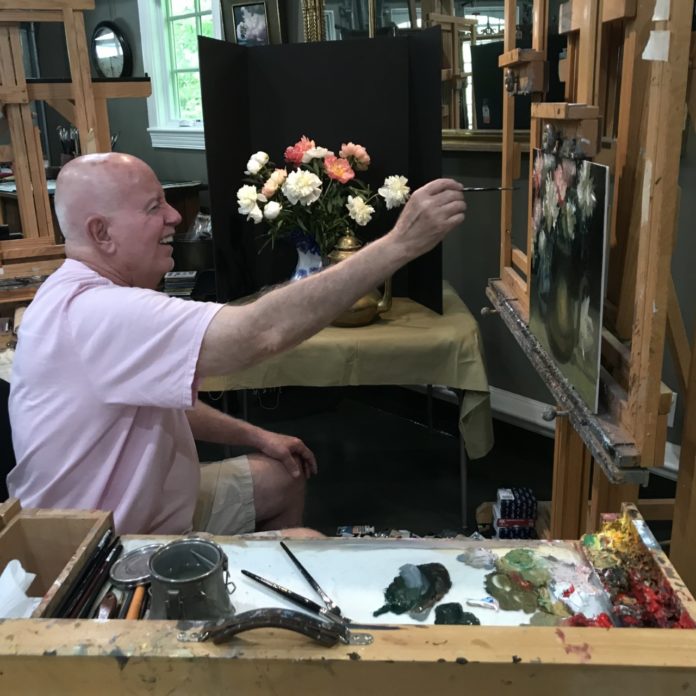As part of an ongoing series in which we feature prominent artists and their art studios, today we present American Impressionist CW Mundy. Mundy calls his studio his home, and his home, his studio. Enjoy.


Cherie Dawn Haas: What did your earliest studio space look like, and how did it change over the years?
CW Mundy: My earliest studio space was a small (10×15’) bedroom in our home, with south-facing windows. I tacked up drywall on the north wall to use as my painting easel. It was sparse but functional. I hung paintings and illustrations all around the room on the walls.
From that earliest space, I moved in 1999 to a 1,250-square-foot industrial space in a 1911 warehouse, the Stutz Building, in downtown Indianapolis. Large windows on the south and west were covered with light-controlled curtains. This space was decorated to emulate a 100-year-old turn of the century studio, such as Sorolla or Sargent might have had. It was decorated with antique furniture, a large oriental rug, antique props and “Pond Yachts” and with special track lighting.
As of autumn of 2020, after over 20 years downtown, I moved home again, now to my remodeled garage space, measuring about 20×25’ with north light windows, and controlled-light from small windows on the east and west walls. We moved what furniture we could from the larger space, but had to downsize.

CDH: What parts of the studio are specific to painting?
CWM: In my new space, I have two Hughes easels of different sizes, a taboret, and a worktable.
I also have two large, antique armoires for storing art supplies and painting props, an antique library table and seating, an antique red settee, and several large mirrors.
For lighting, I currently have two “Method” Art Studio Lights, which are mounted in the ceiling above the easels, and I have ten recessed ceiling lights, with 5000K Northlux Studio Art Lights, which are controllable and dimmable by three different switches.
CDH: How has having a studio space benefited you and your art practice?
CWM: My studio is dedicated to my art and my music (see below). Having my studio at home saves at least an hour of travel every day, as compared to driving to my downtown studio. It is a separate and a designated space where I can go anytime, day or night, without leaving home!

CDH: What’s the most important thing in your studio?
CWM: My “painting station” at the easel is the most important thing in my studio.
CDH: How much time, on average, do you spend there?
CWM: My time spent in the studio varies. I can be in there every day for weeks at a time. Or it can be “off and on,” depending on travel, plein air painting, and music events.

CDH: Based on your experience, what does an art studio need?
CWM: An art studio needs to have a “painting station” with an easel and taboret, controlled light, perfect climate control and ventilation, storage space as with my antique armoires, worktables for varnishing and framing and for still life setups, and a music sound system.
My Hughes easels are crucial for me, in that I can sit or stand in the same place and paint any area of the painting, as the easel moves up and down and also left to right.
CDH: What advice would you give to artists who want to buy, rent, or create a space?
CWM: You need proper ventilation and a very comfortable environment.
Your studio should emulate your personality. Your studio needs to be “you,” not somebody else. It should be an excellent working environment.

More about CW Mundy and his music: World-renowned painter, C.W. Mundy, is expanding his artistic scope through his debut CD, Road Trip.
Currently based in Indianapolis, C.W. Mundy is a Master Signature Member of the Oil Painters of America, he holds Master Status with the American Impressionist Society, and regularly sells out artist workshops nationwide. However, this true renaissance man is also a member of the Disco Mountain Boys, a popular Indy-based bluegrass band consisting of other highly-skilled musicians committed to their current professions, yet in need of a musical outlet.
Mundy has a musical background that extends back to his college days at Ball State University in Indiana, where he was a member of a band called American Gothic, specializing in folk and bluegrass music. After graduation in 1969, he headed to California, where he fell into a musical crowd that included such revered names as Byron Berline, Dan Crary, and Pat Cloud. In 1975, Mundy helped form the Tarzan Swing Band, whose unique blend of jazz, country, blues, bluegrass, and swing landed them a house gig at a club in Redondo Beach, took them on the road, and nearly got them signed to MCA. The band broke up before the opportunity could manifest following the death of the band’s fiddle player, who lost her battle with Hodgkin’s disease. Other musical offers came his way throughout this time, including one from Linda Ronstadt, but ultimately, CW Mundy moved back to Indiana in 1978 and shifted his focus to art, where it has primarily stayed for the past 30 years.
Listen to CW Mundy’s interview with Eric Rhoads on the Plein Air Podcast:
.
> Visit EricRhoads.com to learn about more opportunities for artists and art collectors, including retreats, international art trips, art conventions, and more.
> Sign up to receive Fine Art Today, our free weekly e-newsletter
> Subscribe to Fine Art Connoisseur magazine, so you never miss an issue









